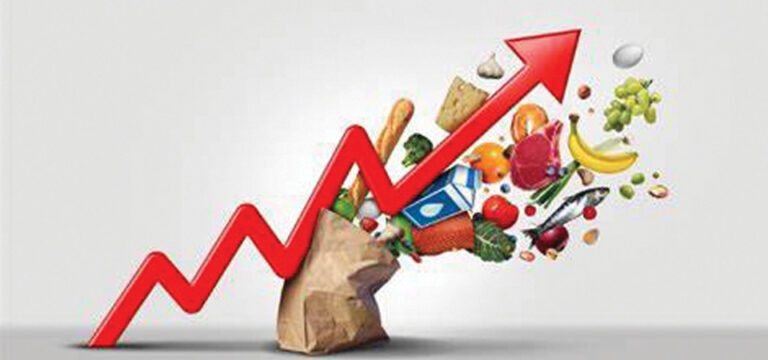
The economic crisis has its toll on price inflation of goods and services.
Consumer price inflation more than doubled to reach 7.14 per cent in the eighth month (mid-March) of Fiscal Year 2021/22 compared to 3.03 per cent a year ago, according to the Current Macroeconomic and Financial Situation report of the Nepal Rastra Bank (NRB).
Food and beverage inflation stood at 7.51 per cent whereas non-food and service inflation stood at 6.84 per cent in mid-March. In mid-April 2021, food and beverage inflation was 3.80 per cent and non-food and service inflation stood at 2.42 per cent.
Price of ghee and oil went up by 26.34 per cent, vegetable by 13.96 per cent, milk products and eggs by 11.30 per cent, and pulses and legumes rose by 10.30 per cent on year-on-year basis.
Likewise, under the non-food and services category, the prices of transportation, miscellaneous goods and services and education sub-categories rose by 16.27 per cent, 9.01 per cent and 8.79 per cent respectively.
In the review month, hill area experienced the highest inflation of 7.69 per cent. The Kathmandu Valley, Terai and Mountain witnessed inflation of 6.31 per cent, 7.36 per cent and 7.56 per cent respectively. Inflation in these regions was 2.50 per cent, 3.25 per cent, 3.40 per cent and 1.31 per cent respectively in mid-March 2021.
Remittances continue to slump
Remittance inflows decreased by 1.7 per cent to Rs. 631.19 billion by the end of the eighth month of the fiscal year against an increase of 8.7 per cent of the previous year.
Number of Nepali workers taking approval for foreign employment increased significantly to 227,900 in the review period. It had decreased by 82.9 per cent in the same period of the previous year. The number of Nepali workers taking approval for making re-entry for foreign employment increased by 240.9 per cent to 178,262. It had decreased by 70.2 per cent in the same period of the previous year.
Net transfer decreased by 2.0 per cent to Rs. 704.33 billion in the review period. Such a transfer had increased by 7.2 per cent last year.
Current account deficit reaches Rs. 463 billion
The report states that the current account remained at a deficit of Rs. 462.93 billion in the eighth month of this year compared to a deficit of Rs. 151.42 billion in the same period of the previous year.
Likewise, capital transfer decreased by 41.2 per cent to Rs. 7 billion and net foreign direct investment (FDI) increased by 60.0 per cent to Rs. 16.30 billion. In the same period of the previous year, capital transfer and net FDI amounted to Rs. 11.91 billion and Rs. 10.18 billion respectively.
BOP deficit continues to grow
Balance of Payments (BOP) remained at a deficit of Rs. 258.64 billion against a surplus of Rs. 68.01 billion of the previous year.
Similarly, gross foreign exchange reserves decreased by 16.3 per cent to Rs. 1171 billion in mid-March 2022 from Rs. 1399.03 billion in mid-July 2021.
The central bank said that based on the imports of eight months of 2021/22, the foreign exchange reserves of the banking sector is sufficient to cover the prospective merchandise imports of 7.4 months, and merchandise and services imports of 6.7 months.
Similarly, deposits at Banks and Financial Institutions (BFIs) increased by 4.1 per cent in the review period compared to an increase of 11.0 per cent in the corresponding period of the previous year.
Private sector credit from BFIs increased by 12.8 per cent this year compared to an increase of 17.4 per cent last year.
Source : TRN,






